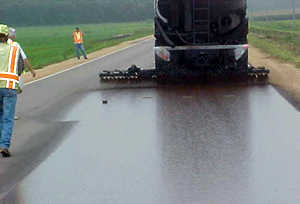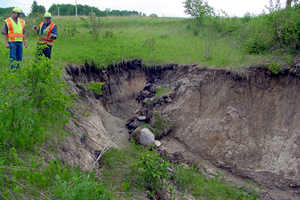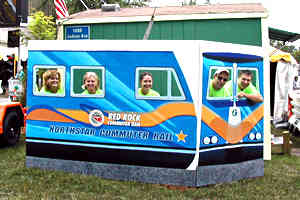 |
 |
|
 |
Maintenance experts explore methods to extend asphalt pavement life |
 |
 |
 |
A spray truck applies one of eight experimental treatments to extend
asphalt pavement life on a section of Hwy 251 near Albert Lea. Photo
by Tom Johnson
|
More than 70 representatives of state and provincial transportation agencies,
consulting firms, contractors and suppliers met in the Twin Cities on Aug. 19-22
to share ideas and observe maintenance practices that can extend pavement life.
One participant, Clayton Linebarger of the Montana DOT, said he welcomed the
workshop to explore ways to increase pavement life in his state, which has 29,000
lane miles of highway in a climate known for temperature extremes.
"We’ve got a 131 maintenance sections and we use crack sealing extensively,
but anything I can learn can help," Linebarger said.
Members of the Midwestern Pavement Preservation Partnership met in Bloomington.
Following the meeting sessions, participants in a subsequent workshop on pavement
sealers and rejuvenators traveled to Albert Lea to view application of eight
experimental pavement treatments on a section of Hwy 251.
Done in cooperation with the Arizona, California, Alabama, Michigan and Minnesota
DOTs, the experiment uses techniques such as chip seals and pavement rejuvenators
to lengthen pavement life. The experiment is being conducted in those states
to evaluate them in various climatic conditions.
Roger Olson, research operations engineer, Materials and Road Research said
the pavement rejuvenators uses compounds that restore the pliability of asphalt
pavement, partly by blocking the effects of ultraviolet light on the pavement
material, to extend its service life.
Sealants protect the surface against intrusion by air and water; rejuvenators
penetrate the pavement to enhance the properties of the asphalt binder in the
existing pavement.
Researchers will observe the test sections for five years to determine their
effectiveness.
The Federal Highway Administration, the Foundation for Pavement Preservation
and Mn/DOT sponsored the meeting of the pavement partnership meeting and the
pavement preservation workshop sessions.
By Craig Wilkins
|
back

|
 |
Floods’ cost exceeds $2 million |
 |
 |
 |
Bemidji/District 2 employees Curt Larson and Ken Larson survey flood
damage suffered by Hwy 11 near Baudette. Flooding this year caused more
than $2 million in damage, including about $1.7 million in Bemidji/District
2. Photo by Stephen Frisco
|
Heavy rains in early summer caused flood damage of more than $2 million in
Districts 2, 3, 4, 6 and 8. Bemidji/District 2 sustained the greatest damage
at nearly $1.7 million.
Floodwaters from swollen creeks and rivers forced dozens of road closures throughout
the state, mainly in northern and northwestern Minnesota.
"We're still working on the damage and will be lucky to finish everything before
winter hits," says Dave Dalager, field maintenance superintendent for Bemidji/District
2.
During the floods, he said, crews worked 30 hours straight to keep rising waters
from inundating the city of Ada. Private contractors and workers from Ada and
Norman County joined Mn/DOT crews in that successful effort.
Mn/DOT hired contractors through emergency orders to do the bigger jobs that
need immediate attention. Mn/DOT crews handled slides and washouts and other
jobs that didn’t affect the immediate road surface.
Dalager says that the bulk of damage in Bemidji/District 2 occurred on Hwy
11, the main east-west link that runs parallel to the Rainy River. The stretch
between Baudette and North Junction was hit particularly hard, he said.
"Everything is open now, but it's not in the shape we'd like it to be," said
Dalager, noting that there's still water in the roadside ditches.
Federal Highway Administration emergency funds cover some costs, but sites
must sustain at least $5,000 in damage to qualify for aid. Mn/DOT pays for any
improvements through its repair budget. FHWA funds will be deposited into the
Trunk Highway Fund.
Dalager praised Mn/DOT people and communities in the region for pulling together
and expressed thanks that no one was hurt during the flood recovery operations.
"We were lucky that there were no major injuries on roadways or among our crews,"
he said.
By Sue Stein
|
back

|
 |
Exhibit workers enjoy ‘fairly’ good time |
 |
 |
 |
Preparing for their shift at the fair, five Willmar/District 8 employees
use the cut out version of a rail car at the exhibit for its intended
purpose: framing portraits of fair visitors. The fair workers are (from
left) Kelly Brunkhorst, Hutchinson; Betty Harrier, Willmar; Shelly Kothe,
Willmar; Paul Jurek, Marshall, and Jim DeLeeuw, Willmar. Photo by
Jim DeLeeuw
|
In addition to eating vast quantities of food on a stick, Minnesota State Fair
visitors are stopping by Mn/DOT’s exhibit to a cast a ballot in the straw poll,
choose their favorite color for road salt this winter and check out a brand
new, high-tech snowplow.
Visitors to the booth on Judson Avenue also take the opportunity to play with
their children in the kids’ shaded activity area, take a trivia quiz and visit
with Mn/DOT employees staffing the exhibit.
Each year, an average of 84,000 people visit the fair booth, said Mary Meinert,
Communications and Public Relations.
This year, she said, visitors have asked frequently about the Hiawatha light
rail line, the proposed Northstar commuter rail line, highway project completions
and a lot of traffic-related questions.
For the first time, the exhibit includes an area staffed by a human resources
person to answer questions and offer assistance to those seeking employment
with Mn/DOT.
Mn/DOT’s presence at the fair also includes the aviation exhibit, located east
of the main exhibit on Judson Avenue, and to the display of a full-sized mock-up
of a car that will be used on the Hiawatha light rail transit line when service
begins in 2004. The LRT car is located on Lee Avenue between Underwood and Cooper
streets.
|
back

|
 |
Employees’ efforts, competence earn public notice |
 |
 |
Mn/DOT employees are known for going the extra mile while doing their jobs.
Two people recently sent letters highlighting these efforts.
Carol Morgan from Thunder Bay, Ontario, Canada, sent Mn/DOT a letter expressing
her gratitude for the excellent assistance she received from Highway Helper
Julie Todora. On June 28, Todora pulled up to an overheated vehicle on Hwy 694.
There she found Morgan and three other occupants in the car, all of whom had
been sitting in the 95-degree heat for more than an hour.
She called AAA to tow Morgan’s car and drove the three other occupants to their
hotel eight miles down the road because everyone could not fit into the tow
truck. She then advised Morgan to have AAA drop off her car at a garage right
near her hotel. Morgan credits Todora for coming to their rescue and applauds
the Highway Helper program that Mn/DOT provides as an excellent service.
"Without it, we would have been stranded—or even worse--one of us could
have become ill," said Morgan.
Mary Lundeen of Vadnais Heights also commended Mn/DOT workers for the work
they are doing with the bridge repair on I-694. She commutes on the stretch
of I-694 between I-35E and I-94 and realizes that these improvements will make
a difference in safety and provide for better driving conditions.
"The men and women on the road crews aren’t appreciated by the public
as they should be," Lundeen wrote.
By Shayla Cain
|
back

|
 |
|
 |



